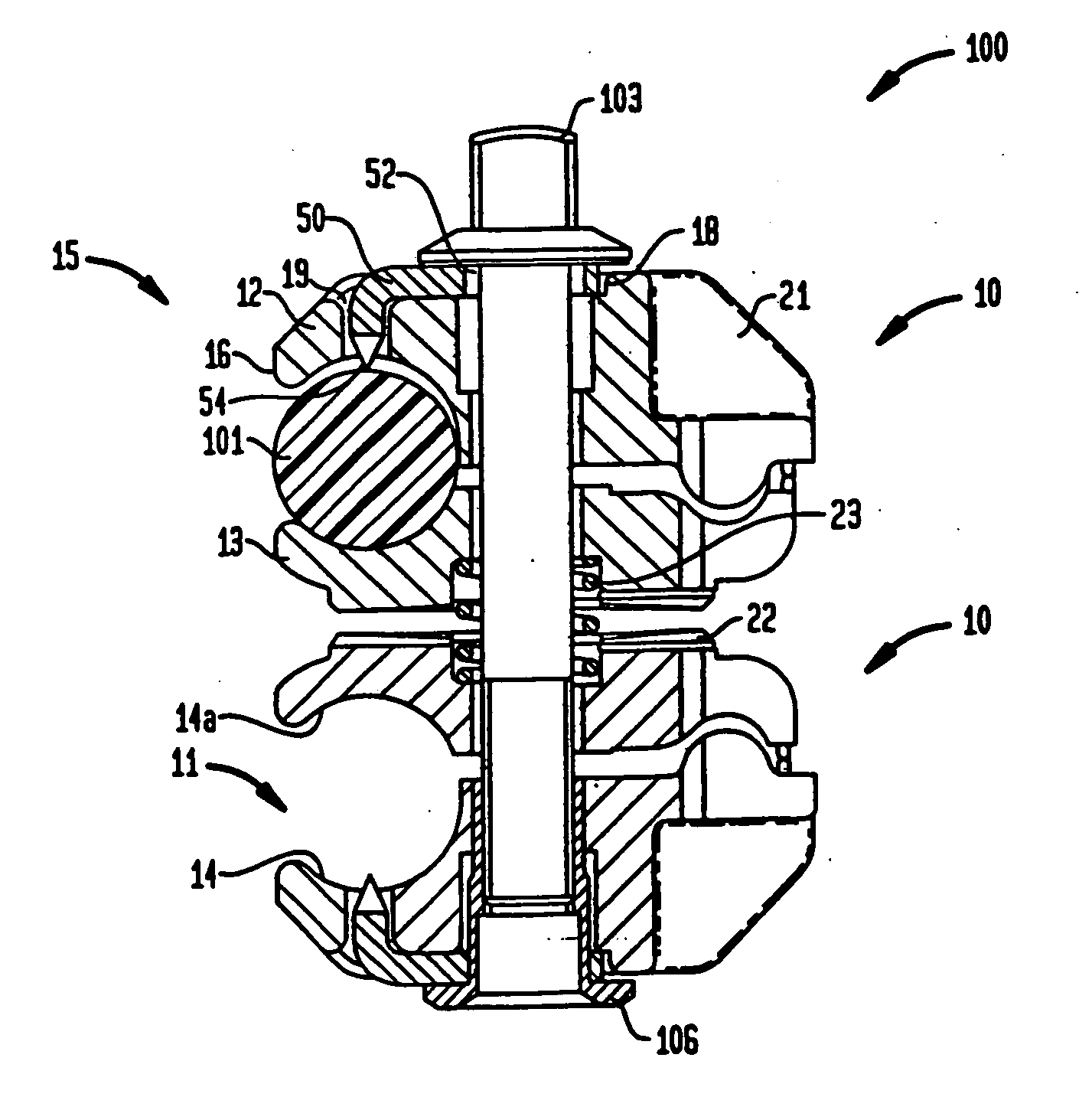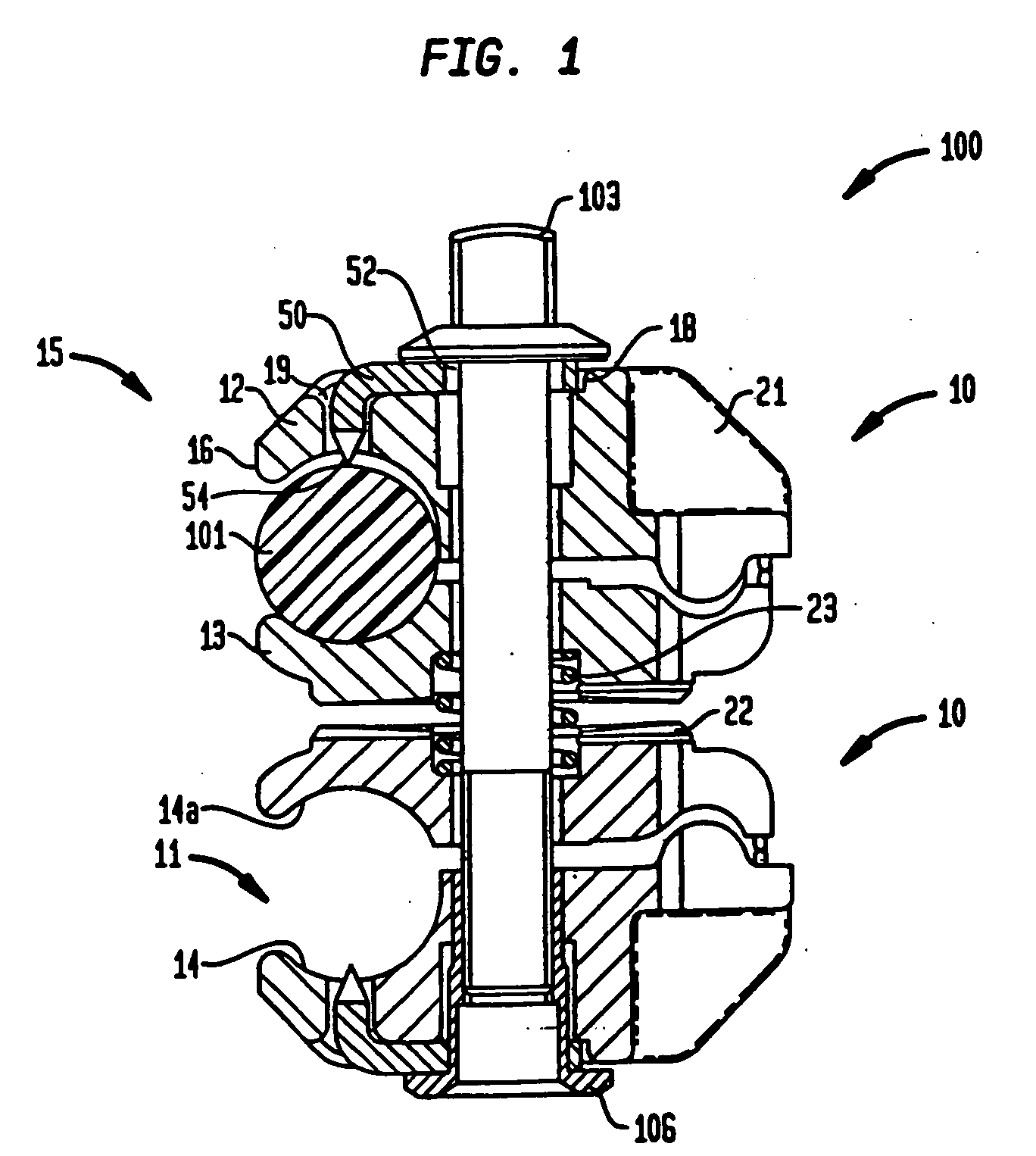External fixation clamp
a clamp and external technology, applied in the field of inserts, can solve the problems of loose connection, inability to find suitable material pairings with which to achieve sufficient fixation, and loss of gripping power of connections that have been tightened
- Summary
- Abstract
- Description
- Claims
- Application Information
AI Technical Summary
Benefits of technology
Problems solved by technology
Method used
Image
Examples
first embodiment
[0047]FIG. 2 shows a perspective view of the first embodiment according to the invention, with an inserted rod 101. The same characteristics in the drawings are shown with the same reference symbols, in each instance. In lower clamping element 10, the break-through of slit bore 19 and two teeth of lower insert 50, which is held by the nut 106, can be seen. Here, the connection between clamping elements 10 is pressed apart by way of a pressure spring 23 that has been inserted between them.
[0048]FIG. 3 shows a perspective view of insert 50 according to the first embodiment, FIG. 4 shows a bottom view of this insert 50, and FIG. 5 shows a side view of the insert 50. In the top view, the insert 50 is essentially a rectangular plate having an oblong bore 52. In cross-section, the insert 50 looks like an L-shaped small plate having a long side 51 and a shorter engagement side 53. Here, the free end of the shorter engagement side 53 ends in two teeth 54, which have a prism shape in cross-s...
second embodiment
[0049]FIG. 6 shows a perspective view of an insert 60 according to a FIG. 7 shows a bottom view of the insert 60 according to FIG. 6, and FIG. 8 shows a side view of the insert 60 according to FIG. 6. The insert 60 is essentially very similar to insert 50, with the difference that here, four teeth 64 are provided, and that the engagement edge 65 of the teeth 64, in each instance, stands crosswise to the longitudinal direction of rod 101, into which it can engage. Therefore the engagement edge 65 of the teeth 64 stands essentially crosswise to the direction of rod 101 and prevents axial displacement of the clamping element 10 on rod 101, in particularly excellent manner.
[0050]FIG. 9 shows a perspective view of on insert 70 according to a third exemplary embodiment, FIG. 10 shows a bottom view of the insert according to FIG. 9, and FIG. 11 shows a side view of the insert according to FIG. 9. In this embodiment variant, the first and second exemplary embodiments are combined, in princ...
sixth embodiment
[0060]FIG. 20 shows a perspective view of an insert 190 according to a FIG. 21 shows a side view of the insert 190 according to FIG. 20, and FIG. 22 shows a bottom view.
[0061]Insert 190 is configured to be rectangular with rounded corners, and, similar to insert 50, has a plate surface 51 that makes a transition into the engagement side 93 on one side, at a slant. This can be achieved by means of punching, for example. The angle between the surface 51 and the engagement side 93 can be 45 degrees, for example, but other values, advantageously between 30 and 60 degrees, are also possible. An oblong hole 92 is disposed in the surface 51; its longitudinal direction is oriented perpendicular to the punch line of the engagement side 93. The smaller diameter of the oblong hole 92 essentially corresponds to the diameter of the screw 103 provided for the clamping element 30 according to FIG. 23. Oblong hole 92 has a region that extends into the slant of the engagement side 93. This is advan...
PUM
 Login to View More
Login to View More Abstract
Description
Claims
Application Information
 Login to View More
Login to View More - R&D
- Intellectual Property
- Life Sciences
- Materials
- Tech Scout
- Unparalleled Data Quality
- Higher Quality Content
- 60% Fewer Hallucinations
Browse by: Latest US Patents, China's latest patents, Technical Efficacy Thesaurus, Application Domain, Technology Topic, Popular Technical Reports.
© 2025 PatSnap. All rights reserved.Legal|Privacy policy|Modern Slavery Act Transparency Statement|Sitemap|About US| Contact US: help@patsnap.com



